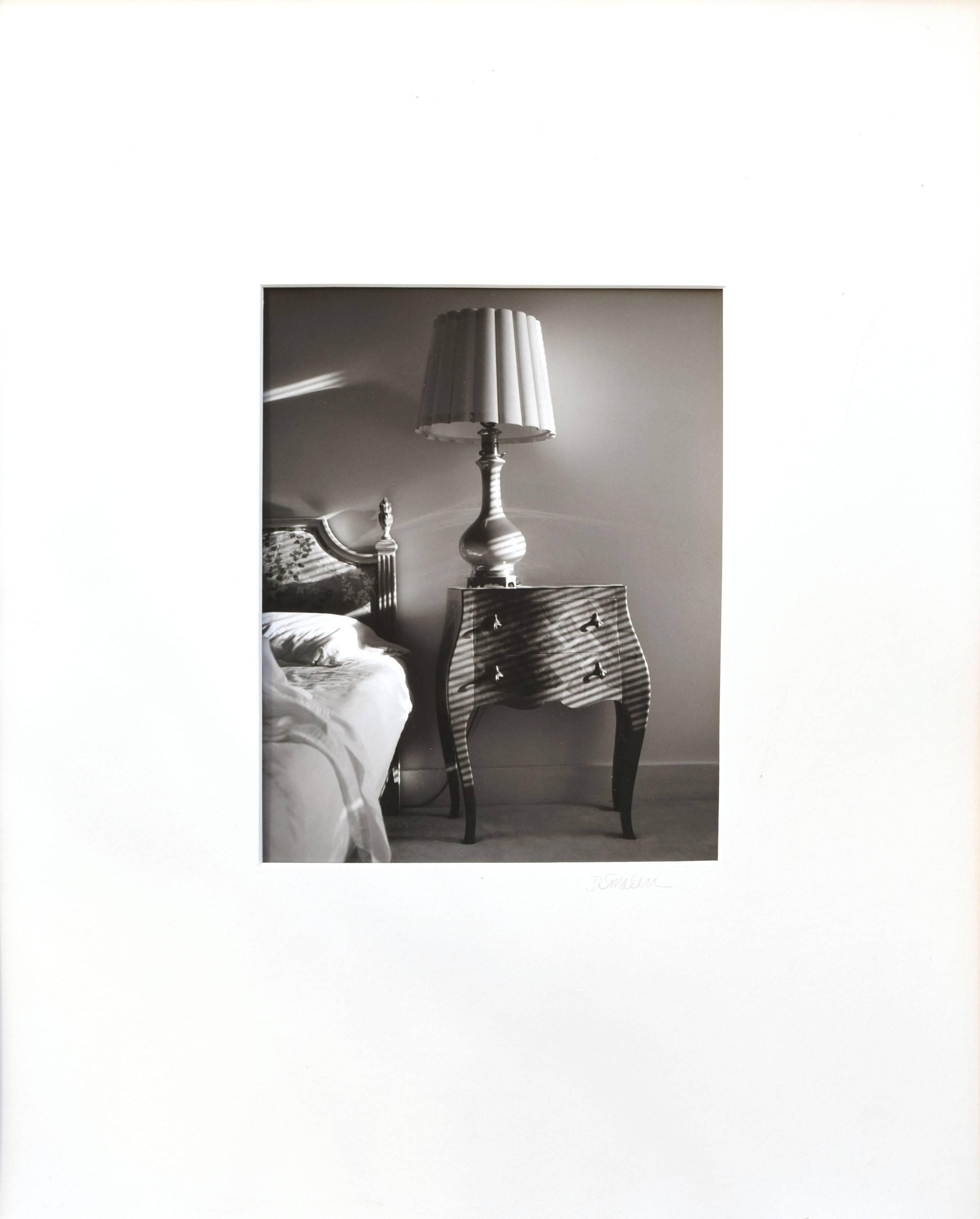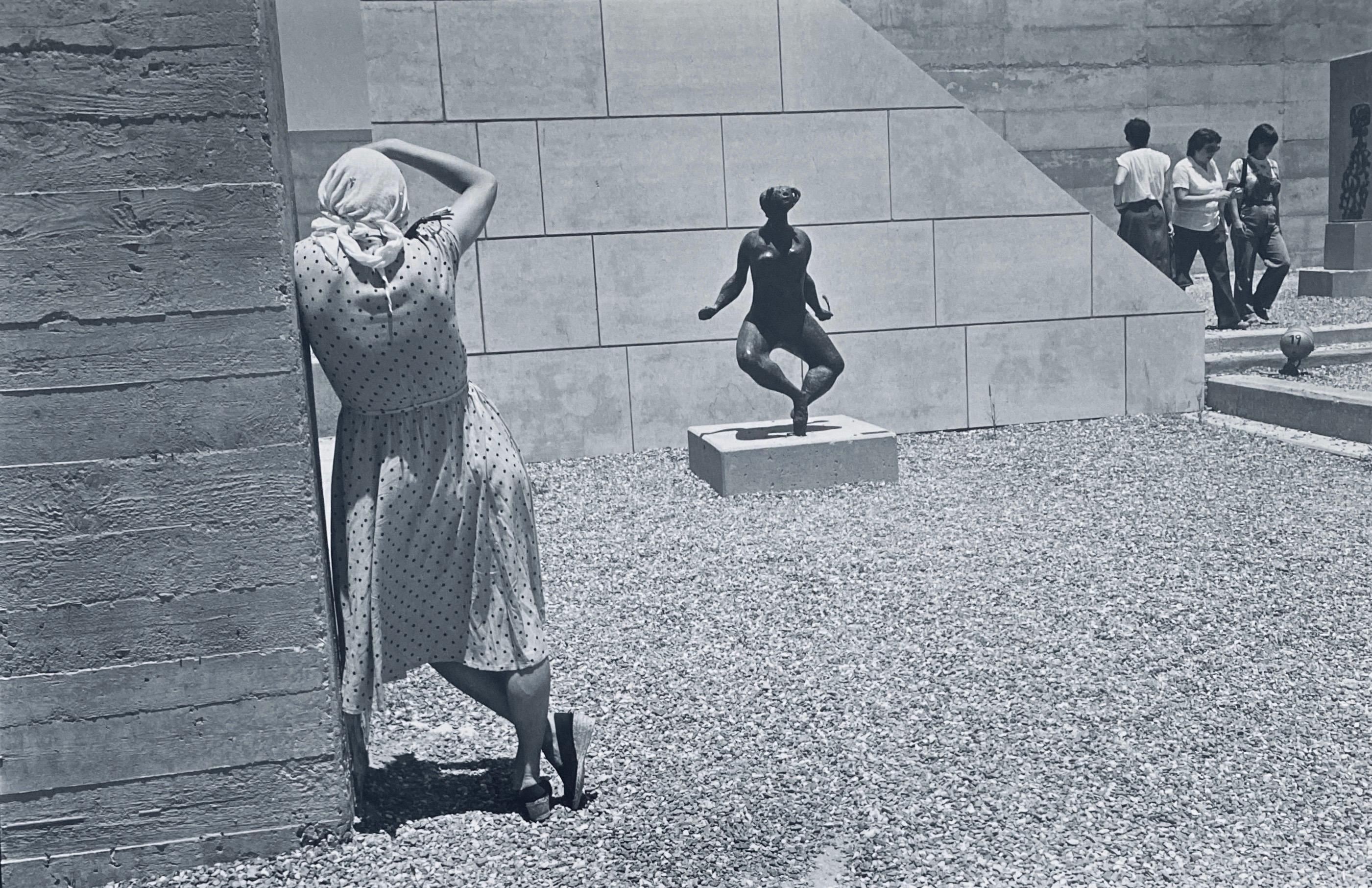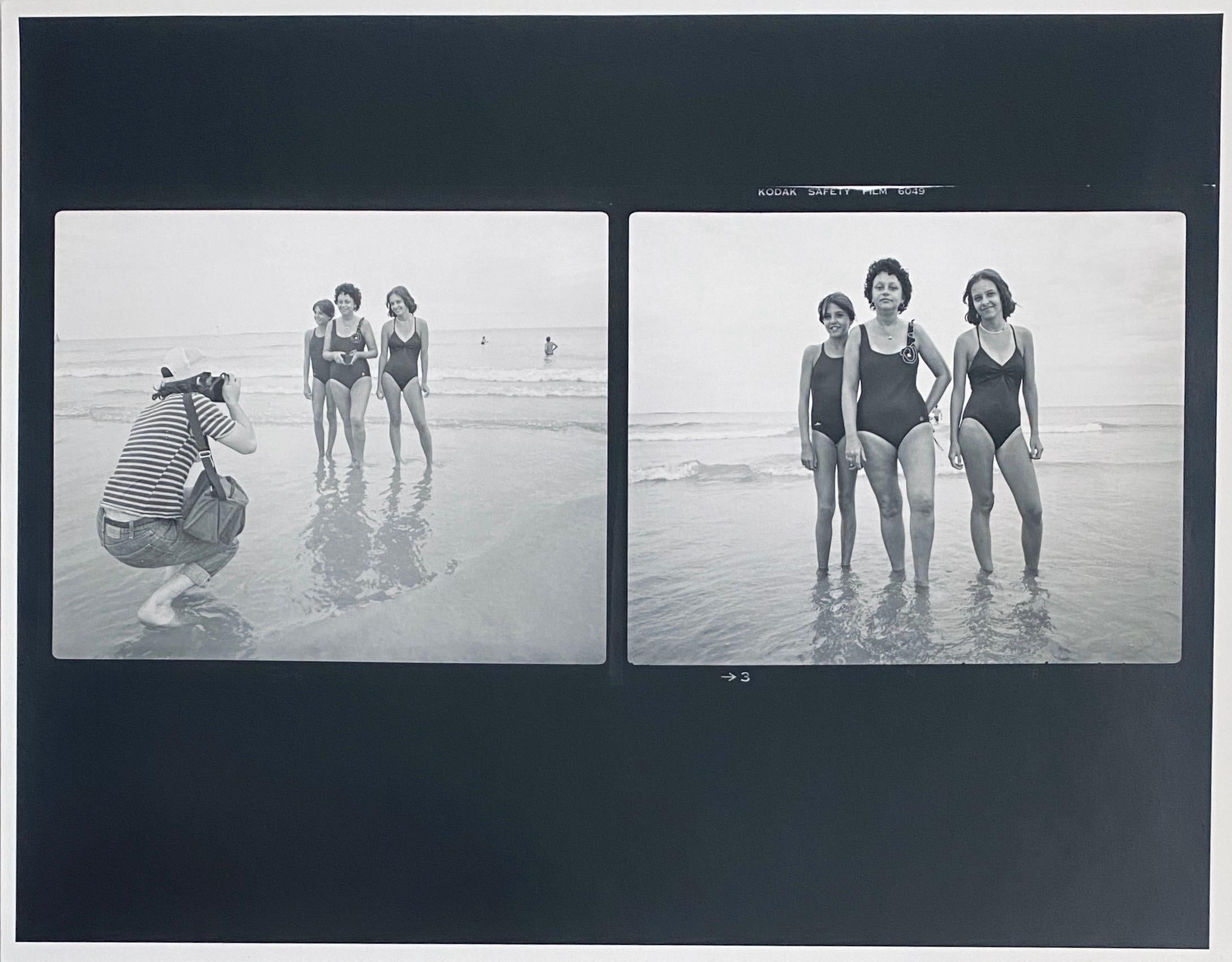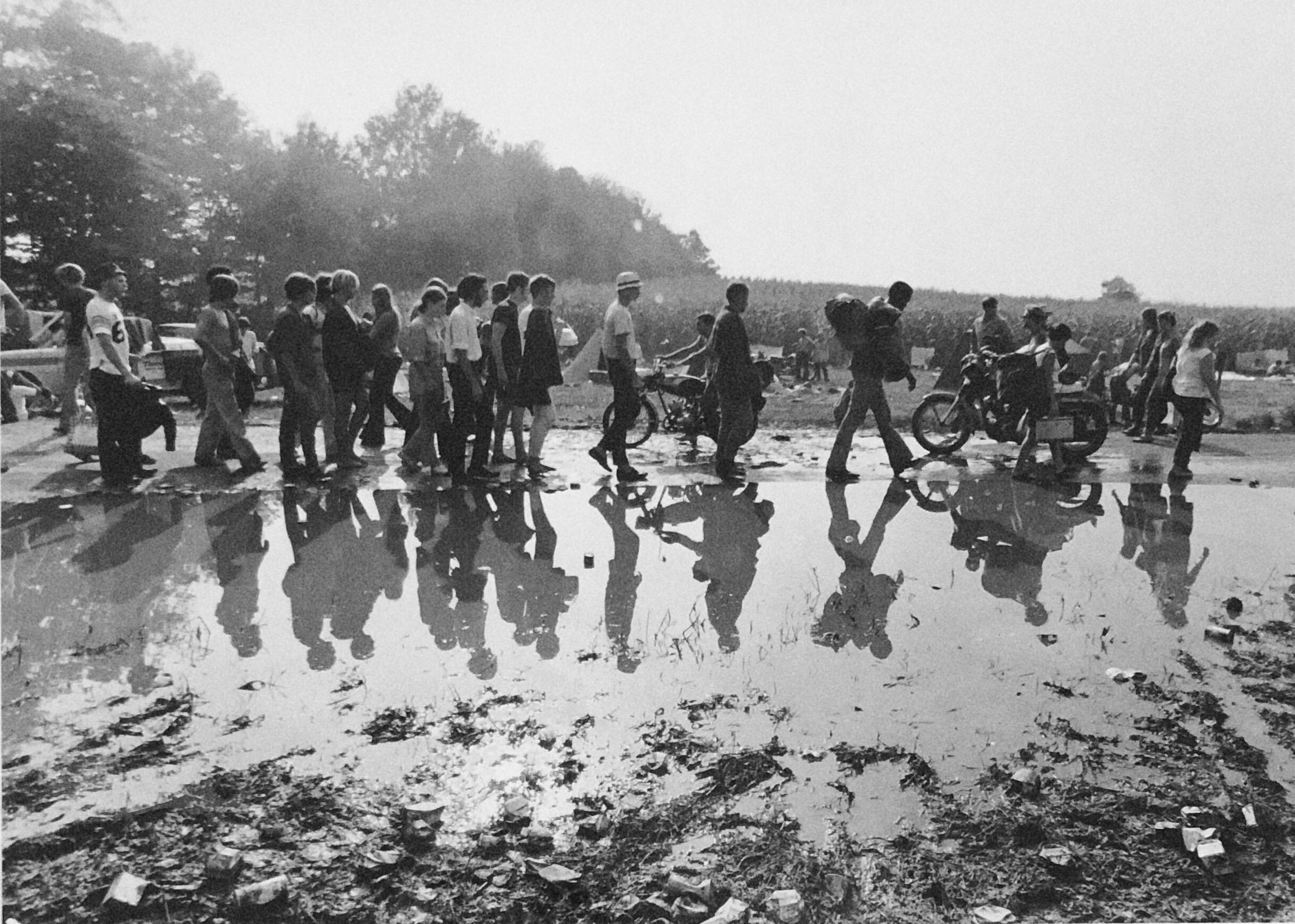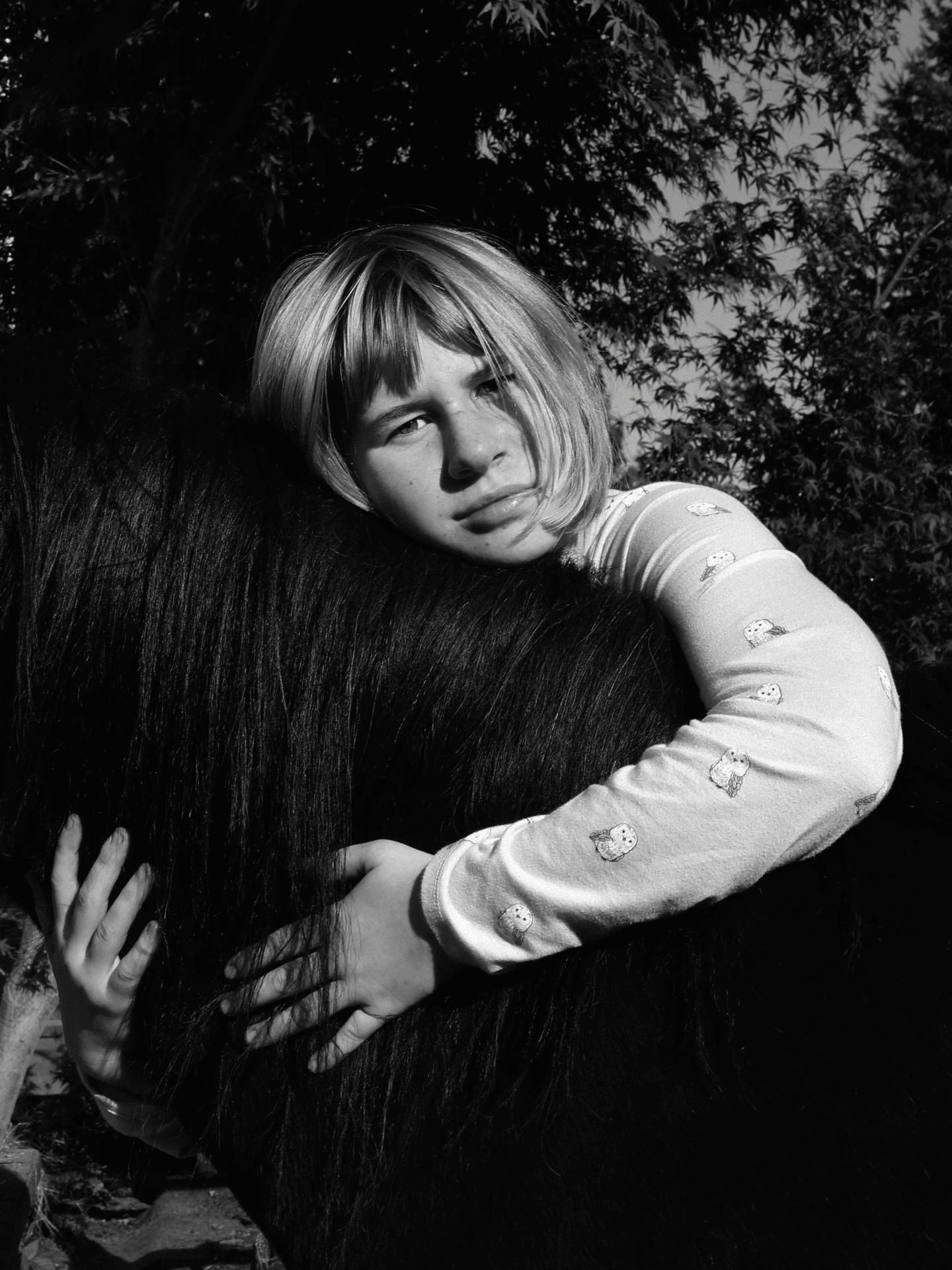Items Similar to David Smith with Voltri XV - Bolton 1963 by Dan Budnik
Want more images or videos?
Request additional images or videos from the seller
1 of 12
Dan BudnikDavid Smith with Voltri XV - Bolton 1963 by Dan Budnik1963
1963
About the Item
DAN BUDNIK (American, b. 1933-2020
David Smith with Voltr1-Bolton XV, Terminal Iron Works, Bolton Landing, N. Y. 1963
Vintage Print on Afga Paper, Silver gelatin, March 1963, printed 1992 by Igor Bakht
Paper: 24 x 20 inches
Image: 16.38 x 13 inches
Recto: signed in black ink in artist's hand
Verso: titled, dated, signed in graphite in artist's hand, printer information in graphite
State: unmounted.
Dan Budnik 1933-2020
As a photojournalist, Dan Budnik is known for his photographs of artists, but also for his photo-documentation of the Civil Rights Movement and of Native Americans. Born in 1933 in Long Island, New York, Budnik studied with Charles Alston at the Art Students League of New York (1951-53) and began his photography career as Philippe Halsman’s assistant. Working at Magnum Photos (1957-64) in 1963, Budnik persuaded Life Magazine to have him create a long-term photo essay showing the seriousness of the Civil Rights Movement, documenting the Selma to Montgomery march and other historical Civil Rights moments. Budnik went on to photograph for premier publications such as Life, Fortune, Look, Newsweek, Sports Illustrated and Vogue.
He has been a major contributor to eight Time-Life Wilderness and Great Cities series and received a 1973 grant from the National Endowment for the Arts for his work on the Hudson River Ecology Project and a 1980 grant from the Polaroid Foundation for Big Mountain: Hopi-Navajo Forced Relocation.
Biography
Pastaza, Ecuador, December 2004 Photo by Kresta King Cuther
Pastaza, Ecuador, December 2004 Photo by Kresta King Cuther
Dan Budnik, (b. 1933-died 2020), whose career as a photographer has spanned more than half a century, was most recent recipient, in 1998, of the prestigious American Society of Media Photographers Honor Roll Award, an accolade previously accorded to such eminent photographers as Man Ray, Edward Steichen, Walker Evans, Dorothea Lange, André Kertész, Ernst Hass, and Henri Cartier-Bresson. After studying with Charles Alston at the Art Students League of New York (1951-53), Budnik began his career as a Magnum photographer.
His photo-essays have appeared in periodicals that include Art in America, LIFE Magazine, Fortune, The London Sunday Times, Magazine, Look, Modern Photography, Newsweek, The New York Times Magazine, Réalités and Vogue. He has been a major contributor to many books, including six from the Time-Life Wilderness and Great Cities series. Budnik’s photographs appear in “The Museum: An Informal Introduction to The Museum of Modern Art” by Richard Schickel (1970). He is included in two seminal histories of photography: Nathan Lyons’ “Photography in the Twentieth Century” (1967) and “The Picture History of Photography from the Earliest Beginnings to the Present Day”, by Peter Pollack (1977).
Dan Budnik lives in Tucson, Arizona and is currently involved with creating a photographic record of ancient petroglyphs. Widely acclaimed for his photo-documentation of Native Americans (including his collaboration with Sandy Johnson on “The Book of Elders: The Life Stories of Great American Indians”, 1994), the Civil Rights Movement, and environmental issues. Budnik received a 1973 grant from the National Endowment for the Arts for his work on the Hudson River Ecology project and a 1980 grant from the Polaroid Foundation for Big Mountain: Hopi-Navajo Forced Relocation.
The scope of Dan Budnik’s documentation of major 20th century artists has yet to be fully recognized. In addition to David Smith, he photographed Georgia O’Keeffe, Lee Bontecou, Alexander Calder, John Chamberlain, Willem de Kooning, Helen Frankenthaler, Jasper Johns, Roy Lichtenstein, Robert Motherwell, Mark Rothko, and many others.
Dan Budnik’s photographs of David Smith first appeared as an April 5, 1963 photo essay for LIFE Magazine. They were first exhibited, in 1974, at the University Art Museum State University of New York, Albany, The Cooper Union for the Advancement of Science and Art, New York, and Rice University, Houston, Texas. The same exhibition circulated nationally under the auspices of the American Federation of Arts, from 1975-78. They have been widely published, and have become an essential part of the extensive body of literature on Smith. Twenty-four of Budnik’s photographs of Smith are reproduced in the catalogue of the current exhibition at The Solomon R. Guggenheim Museum, David Smith: A Centennial.
Selected Public Collections
Albright-Knox Art Gallery, Buffalo, New York
The Albuquerque Museum, New Mexico
Center for Creative Photography, The University of Arizona, Tucson
The Cleveland Museum of Art, Ohio
Guild Hall, East Hampton, New York
Indiana University Art Museum, Bloomington
Museum Ludwig, Cologne, Germany
Museum of Fine Arts, Houston, Texas
The Museum of Modern Art, New York
Museum of New Mexico, Santa Fe
Harry Ransom Center, The University of Texas at Austin
Roswell Museum and Art Center, New Mexico
Seattle Art Museum, Washington
Worcester Art Museum, Massachusetts
- Creator:Dan Budnik (1933, American)
- Creation Year:1963
- Dimensions:Height: 19.38 in (49.23 cm)Width: 13 in (33.02 cm)
- Medium:
- Movement & Style:
- Period:
- Condition:DAN BUDNIK (American, b. 1933-2020 David Smith with Voltr1-Bolton XV, Terminal Iron Works, Bolton Landing, N. Y. 1963 Vintage Print on Agfa Paper, Silver gelatin, March 1963, printed 1992 by Igor Bakht Paper: 24 x 20 inches Image: 16.38 x 13 inches.
- Gallery Location:Phoenix, AZ
- Reference Number:1stDibs: LU2623212945372
About the Seller
No Reviews Yet
Vetted Seller
These experienced sellers undergo a comprehensive evaluation by our team of in-house experts.
1stDibs seller since 2023
- ShippingRetrieving quote...Ships From: Phoenix, AZ
- Return PolicyThis item cannot be returned.
More From This SellerView All
- Western FlareLocated in Phoenix, AZWestern Flare Terrence Moore Photograph, Archival Pigment Print Size: 23 x 34.5 inches SPECIAL EDITION OF 25, PRICE FOR THE HOLIDAYS Terrence Moore has been up and down and over po...Category
1970s Contemporary Color Photography
MaterialsArchival Pigment
- Longhorns by Lon MegargeeLocated in Phoenix, AZLon Megargee 1883-1960 "Self Portrait" Wood block print Signed in plate, lower right Image size: 15.63 x 12 inches Frame size xx x xx inches Creator of S...Category
1930s American Impressionist Animal Prints
MaterialsScreen
- The Sheepherder by Lon MegargeeLocated in Phoenix, AZLon Megargee 1883-1960 "The Sheepherder" Wood block print Signed in plate, lower right Image size: 10 x 10 inches Frame size 22 x 22 inches Creator of Stetson's hat logo "Last Drop from his Hat" Lon Megargee 1883 - 1960 At age 13, Lon Megargee came to Phoenix in 1896 following the death of his father in Philadelphia. For several years he resided with relatives while working at an uncle’s dairy farm and at odd jobs. He returned to Philadelphia in 1898 – 1899 in order to attend drawing classes at the Pennsylvania Academy of the Fine Arts. Back in Phoenix in 1899, he decided at the age of 16 to try to make his living as a cowboy. Lon moved to the cow country of Wickenburg, Arizona where he was hired by Tex Singleton’s Bull Ranch. He later joined the Three Bar R. . . and after a few years, was offered a job by Billy Cook of the T.T. Ranch near New River. By 1906, Megargee had learned his trade well enough to be made foreman of Cook’s outfit. Never shy about taking risks, Lon soon left Cook to try his own hand at ranching. He partnered with a cowpuncher buddy, Tom Cavness, to start the El Rancho Cinco Uno at New River. Unfortunately, the young partners could not foresee a three-year drought that would parch Arizona, costing them their stock and then their hard-earned ranch. Breaking with his romantic vision of cowboy life, Megargee finally turned to art full time. He again enrolled at the Pennsylvania Academy of Art and then the Los Angeles School of Art and Design during 1909 – 1910. The now well-trained student took his first trip to paint “en plein air” (outdoors) to the land of Hopi and Navajo peoples in northern Arizona. After entering paintings from this trip in the annual Territorial Fair at Phoenix, in 1911, he surprisingly sold his first oil painting to a major enterprise – the Santa Fe Railroad . . . Lon received $50 for “Navajos Watching the Santa Fe Train.” He soon sold the SFRR ten paintings over the next two years. For forty years the railroad was his most important client, purchasing its last painting from him in 1953. In a major stroke of good fortune during his early plein-air period, Megargee had the opportunity to paint with premier artist, William R. Leigh (1866 – 1955). Leigh furnished needed tutoring and counseling, and his bright, impressionistic palette served to enhance the junior artist’s sense of color and paint application. In a remarkable display of unabashed confidence and personable salesmanship, Lon Megargee, at age 30, forever linked his name with Arizona art history. Despite the possibility of competition from better known and more senior artists, he persuaded Governor George Hunt and the Legislature in 1913 to approve 15 large, historic and iconic murals for the State Capitol Building in Phoenix. After completing the murals in 1914, he was paid the then princely sum of roughly $4000. His Arizona statehood commission would launch Lon to considerable prominence at a very early point in his art career. Following a few years of art schooling in Los Angeles, and several stints as an art director with movie studios, including Paramount, Megargee turned in part to cover illustrations for popular Western story magazines in the 1920s. In the 1920s, as well, Lon began making black and white prints of Western types and of genre scenes from woodblocks. These prints he generally signed and sold singly. In 1933, he published a limited edition, signed and hard-cover book (about 250 copies and today rare)containing a group of 28 woodblock images. Titled “The Cowboy Builds a Loop,” the prints are noteworthy for strong design, excellent draftsmanship, humanistic and narrative content, and quality. Subjects include Southwest Indians and cowboys, Hispanic men and women, cattle, horses, burros, pioneers, trappers, sheepherders, horse traders, squaw men and ranch polo players. Megargee had a very advanced design sense for simplicity and boldness which he demonstrated in how he used line and form. His strengths included outstanding gestural (action) art and strong figurative work. He was superb in design, originality and drawing, as a study of his prints in the Hays collection reveals. In 1944, he published a second group of Western prints under the same title as the first. Reduced to 16 images from the original 28 subjects, and slightly smaller, Lon produced these prints in brown ink on a heavy, cream-colored stock. He designed a sturdy cardboard folio to hold each set. For the remainder of his life, Lon had success selling these portfolios to museum stores, art fairs and shows, and to the few galleries then selling Western art. Drawing on real working and life experiences, Lon Megargee had a comprehensive knowledge, understanding and sensitivity for Southwestern subject matter. Noted American modernist, Lew Davis...Category
Early 20th Century American Impressionist Figurative Prints
MaterialsWoodcut
- Hi Mom I Made It by Bill SchenckBy Bill SchenckLocated in Phoenix, AZHi Mom I Made It, 1988 Bill Schenck Serigraph Size: 26 x 30 inches The artist, Billy Schenck, has been known internationally for the past 43 years as one of the originators of the contemporary “Pop” western movement, and an American painter who incorporates techniques from Photo-Realism with a Pop Art sensibility to both exalt and poke fun at images of the West. Like the heroes he idolized in B-Westerns, Schenck might well be called the “Good Badman” of Western American art. Early in his career he became known for appropriating cinematic imagery, which he reproduced in a flattened, reductivist style, where colors are laid side-by-side rather than blended or shadowed. Drawing upon narrative tensions that have attracted mass audiences to western fiction and movies, Schenck added hot colors, surreal juxtapositions, and stylized patterning to explore clashes between wilderness and civilization, the individual and community, nature and culture, freedom and restriction. His irreverence in associating western heroes with racism, the drug scene, consumerism and sexuality led to an evolving series of works. Among them one finds deserts populated with cowgirls sipping champagne on the bumpers of Rolls Royces, Native Americans contemplating the statistics of their land loss, and “cerealized” self-portraits of the artist in leather and sunglasses. Collier Gallery has been in continuous operation for over 40 years. Originally located just off Main Street in downtown Scottsdale, Arizona, we have moved to Tempe to accommodate and showcase our large inventory including: • Original works by Maynard Dixon, Lon Megargee...Category
1980s Contemporary Figurative Prints
MaterialsScreen
- BroncoLocated in Phoenix, AZLuis Alfonso Jimenez Born, 1940, El Paso, Texas, died 2006, Hondo, New Mexico. Statement: Luis Jimenez, in his work, celebrates the vitality of life. . . . Jimenez es un hijo de la frontera; he knows its people and the landscape. It is the transformation of these people into art that is his most important contribution to the art of this vast region which stretches between Mexico and the United States. His subject matter utilizes the popular images of the cultura del norte, and a large part of it is depicted and transformed in the rough and tumble world of la frontera. He is also a son of el norte, and so he uses its materials and explores its emerging, popular myths. The tension and attraction of Jimnez’s work is that he always creates within the space of his two worlds, the Mexicano and the Americano. He constantly shows us the irony of the two forces which repel, while showing us glimpses of the synthesis he seeks. What a gift it has been to us for this talented artist to reflect on the soul of our region. He gives meaning to our existence and history. Rudolfo Anaya (passage chosen by the artist), A View from La Frontera, Man on Fire: Luis Jimnez, pp. 1, 3, 6Biography: Luis Jimnez was born in Texas to parents who had emigrated from Mexico to the United States; he would later dedicate his 1989 sculpture Border Crossing to his father, who had entered the country illegally. The elder Jimnez was a neon sign designer in El Paso, and Luis worked with him as a youth. His experience working in the neon shop and his fascination with U.S. car culture would both become major influences on his art career. Jimenez studied architecture at the University of Texas, Austin (UTA), and also took art courses in which he first created sculptures with wood, steel, and fiberglass, choosing the latter because of its association with U.S. popular culture. He subsequently became one of the artists who made fiberglass an acceptable medium in the 1960s. In 1964 Jimenez received his B.S. in art from UTA, and he continued his studies at the Universidad Nacional Autnoma de Mexico in Mexico City. In 1966 he moved to New York City and worked as an assistant to sculptor Seymour Lipton. Jimnez began to exhibit his art while in New York and in 1972 moved to New Mexico to focus on creating public sculptures, even as he maintained his diverse output of drawings, prints, and lithographs. Drawing on his early experiences, Jimnez creates works that come from a border perspective, one that draws upon the hybridity bred by culture clashes. Often socially and politically informed, his works speak not only in regional terms, those germane to the southwestern United States, but to broader, more global issues as well. They exhibit a profoundly Chicano aesthetic and sensibility, one that is informed by Mexican and Mexican American traditions, North American popular culture, Chicano cultural icons, and images and themes unique to the Southwest. Death, sexuality, and the struggle of the common people are frequent themes. Inspired by authors who write in an autobiographical style, Jimnez creates works that function as personal narrative yet are also able to make statements about culture in more global terms. His use of bold colors and lines, a legacy from his fathers work as a neon sign maker, lends a dynamic sensuality to his work, one that is particularly evident in his monumental fiberglass and acrylic urethane sculptural works Many of Jimnezs works correspond to scholar Toms Ybarra-Fraustos definition of the Chicano aesthetic of rasquachismo, a lowbrow sensibility that appeals to the working class in that it applies to objects that subvert expressions of the mainstream or dominant culture. Creating art that speaks to the people, Jimnez is able to transform regional and culturally specific myths and symbols into globally recognized and relevant icons. Exhibitions: In addition to his personal work, Jimnez has been commissioned for numerous public art projects. In 1999 his sculpture Southwest Piet was designated a National Treasure by First Lady Hillary Clinton. The many exhibitions featuring his work have included Human Concern/Personal Torment (Whitney Museum of American Art, New York, 1969). The First International Motorcycle Art Show (Phoenix Art Museum, Phoenix, AZ, 1973). Three Texas Artists (Centre Cultural Americaine, USIS, Paris, 1977), Recent Trends in Collecting (Smithsonian Institution, Washington, DC, 1982). Committed to Print (Museum of Modern Art, New York, 1989) Printmaking in Texas: The 1980s (Modern Art Museum, Fort Worth, TX. Laguna Gloria Art Museum, Austin, 1990. The Whitney Biennial (Whitney Museum of American Art, New York, 1991) Man On Fire: Luis Jimnez (Albuquerque Museum of Art, NM, 1994-95). 47th Annual Purchase Exhibition (American Academy of Arts and Letters, New York, 1995). Traveling solo exhibition, Working Class Heroes: Images from the Popular Culture (1997-2000). Jiménez Collier Gallery has been in continuous operation for over 40 years. Originally located just off Main Street in downtown Scottsdale, Arizona, we have moved to Phoenix to accommodate and showcase our large inventory including: • Original works by Maynard Dixon, Lon Megargee, Ed Mell, Fritz Scholder, Bill Schenck, Bill Lesch, Luis Jimenez, Greg Singley, Dan Budnik, and other 20th century Western, WPA and Contemporary Southwestern artists. • The Fine Art Estate of Lon Megargee • Vintage rodeo...Category
1970s Contemporary Figurative Prints
MaterialsLithograph
- Apache Mountain Spirit DancerLocated in Phoenix, AZApache Mountain Spirit Dancer James Rome Etching 62/100 Image: 21.75 x 27.5 inches Paper: 25 x 31 inches Rome was born in 1936 in Clearwater County, Minnes...Category
1980s Contemporary Figurative Prints
MaterialsEtching
You May Also Like
- Table with Lamp - Black & White Bedroom Interior PhotographLocated in Soquel, CASilver Photographic print of a bedside table and lamp by D. Smalen. Signed lower Right on mat "D. Smalen." Circa 1980-90. Size 10"H x 8"W , Sight, 9"H x 7.25"W, Mat, 16"H x 20"W.Category
1980s American Modern Black and White Photography
MaterialsPhotographic Paper, Silver Gelatin
- Vintage Silver Gelatin Print Photo Israel Museum Sculpture Jerusalem PhotographLocated in Surfside, FLSusan Hacker -Israel Museum, Sculpture Garden, Jerusalem, Israel, 1979 Silver Gelatin black/white photograph, printed in 1983, hand signed, titled (Jerusalem) and noted. There is no edition size stated Location (Jerusalem), shoot date (1979) and photo print date (1983) and signature in pencil on the bottom back of the photograph. This is of the sculpture Woman skipping rope by Luciano Minguzzi located in the Isamu Noguchi designed sculpture garden at the Israel Museum Image size: 22 x 33 cm Paper size: 28 x 35.5 cm Susan Hacker (1949) is an American photographer and author. She developed and expanded the photography department at Webster University in St. Louis. Her work is in the possession of at least 25 major museums and libraries around the world. There are also many books and publications about her. Has always experimented with many photographic techniques. Hacker is recognized as an innovator of the modern photography art. Susan Hacker Stang (born Susan Hacker, October 19, 1949) is an American photographer, author, and educator. Stang served on the faculty of communications at Webster University in St. Louis from 1974 through 2015 and now holds the title Professor Emeritus. She helped found and build the respected photography program there, heading it for most of her tenure at the university. Her work has been collected by more than 25 major museums and libraries around the world and appears in half a dozen books and numerous magazines. Much of her photography involves the innovative use of alternative cameras, formats, techniques, and media, as evidenced by her two books Encountering Florence (featuring subtly surreal black and white prints of the Italian city using 8 x 10 Polaroid emulsion transfers) and Kodachrome – End of the Run: Photographs from the Final Batches (which chronicles a six-month university photography project in which students and staff would shoot more than 100 roles of rare Kodachrome film for processing on the last day of operations by the world's last remaining Kodachrome processing lab.) In 2016, she published a book of photographs, reAPPEARANCES, which is a sequence of fifty-two photographs made with a digital toy camera (the JOCO VX5). The volume purports to take the viewer on a visual journey through the uncanny coherence of the look of the world, according to Stang's introductory essay. Stang majored in photography at the Rhode Island School of Design, where she earned both a BFA (1971) and MFA (1974), and studied under photographers Harry Callahan and Aaron Siskind. In 1971 she moved to London where she worked as a photographer for the British fashion magazine NOVA (published 1965–1975). She joined the faculty of Webster University in St. Louis in 1974, where she helped found and build the photographic studies program in the School of Communications. In Jerusalem in 1979 she was Artist-In-Residence at the Bezalel Academy of Arts and Design. In recent years, in addition to her work as head of the Webster University photography program and professor of communications, she has taught summer photography workshops in Florence, Italy, both at the Santa Reparata International School of Art (SRISA) and The Darkroom. She taught at Webster for 41 years and earned the Kemper Award for Excellence in Teaching. Stang's photography characteristically employs alternative cameras (such as the Olympus Pen-FT half-frame camera, the Kodak Brownie, and the Holga), or alternative formats (such as Polaroid emulsion transfers) and techniques. Her book of Polaroid emulsion transfers, Encountering Florence was published simultaneously in the U.S. and in Italy (under the title Firenze un Incontro) in 2007. Stang's use of the emulsion transfer process involves transferring the fragile, fabric-like emulsion layer of the photograph (bearing the image) to another surface, subtly transforming the original image in a variety of ways. The results were described in Photo Review as giving Stang's portraits of Florence's buildings, streets, statuary, and gardens "a delicate, draping quality ... reminiscent of the fabrics draped on the ancient statues within the images". An Italian reviewer observed that the photographic process presents "a city not previously seen and perhaps a little disquieting". The book's bi-lingual text in English and Italian was selected and edited by Stang and by Andrea Burzi and Susanna Sarti, both of Florence, to present accompanying word-portraits from authors in their own encounters with the city. A portfolio of Stang's work for the book is held by the Rare Books Collection of the Biblioteca Nazionale Centrale Firenze. In 2010–11, Stang led the Webster University photography program in a six-month-long focus on the color reproduction qualities of Kodachrome film (long revered by professional and amateur photographer for its true, lush color rendition qualities) to mark the permanent discontinuing of the film's production by Kodak. The project ultimately turned into a book documenting the final demise of the medium, and the last day of Kodachrome production anywhere in the world (at Dwayne's Photo in Parsons, Kansas, on January 18, 2011). The last days of processing were covered by The New York Times, National Geographic, and network television. Edited by Stang and fellow photographer Bill Barrett, Kodachrome: End of the Run presents a selection of four-score Kodachrome images shot on more than 100 roles of the film by Webster University students, faculty, and staff over a five-month period and processed by Dwayne's in the final hours as the last processing chemicals ran out. The book includes essays by Stang, Time Magazine worldwide pictures editor Arnold Drapkin, and Dwayne's Photo vice president Grant...Category
1970s American Modern Black and White Photography
MaterialsSilver Gelatin, Photographic Paper
- Vintage Silver Gelatin Photograph Print, Girls on a Beach Photo, Two Man ShowLocated in Surfside, FLRichard Lebowitz, b. 1937, American, (RISD Faculty 1964-1995, Photography; Professor Emeritus) Tom Young, b. 1951, American, (RISD MFA 1977, Photography) TIT...Category
1980s American Modern Black and White Photography
MaterialsPhotographic Paper, Silver Gelatin
- Original Fred Mcdarrah Press Photograph 1960's Woodstock Music Festival PhotoBy (after) Fred McdarrahLocated in Surfside, FLPeople walking alongside puddle at Woodstock in Bethel NY 1969 Photographer is Fred McDarrah Over a 50-year span, McDarrah documented the rise of the Beat Generation, the city’s po...Category
1960s American Modern Black and White Photography
MaterialsPhotographic Paper
- Original Fred Mcdarrah Press Photograph 1960's Woodstock Music Festival PhotoBy (after) Fred McdarrahLocated in Surfside, FLPeople walking alongside puddle at Woodstock in Bethel NY - 1969 Photographer is Fred McDarrah Over a 50-year span, McDarrah documented the rise of the Beat Generation, the city’s ...Category
1960s American Modern Black and White Photography
MaterialsPhotographic Paper
- RowanLocated in Detroit, MIRowan, Archival film photograph with frame, 2018 Raised in the American West, this region has resonated in mythical proportions within Antonia Stoyanovich...Category
21st Century and Contemporary American Modern Portrait Photography
MaterialsArchival Ink, Photographic Paper
